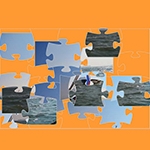
 |
Jigsaw |
Everybody, young and old, loves jigsaw puzzles. This is a classic game that involves joining interlocking pieces to make a whole picture.
| Difficulty levels (see below) | |
| Return to the original face design | |
| Exit |
On opening the game a full picture will appear. It stays there for a few seconds and then its pieces are broken up and randomly scattered over the top of the puzzle board.
When the pieces are dragged into the correct place, the connecting line to the adjoining piece will disappear. If it does not disappear, click on the piece again to position it exactly. Once pieces are positioned correctly they will be locked into place.
When still loose, puzzle pieces can be moved anywhere around the puzzle board. Sometimes puzzle pieces may appear to be covered by the half completed puzzle, but their outline will be visible. Click on the top pieces to make them go behind the piece you want.
The level of difficulty can be changed at any time in the game. The current puzzle picture will stay the same.
When completed successfully, an accompanying sound will be heard and the next puzzle will appear.
Click on the piece outline icon to remove the outlines from the puzzle, making it slightly harder.
To exit, click on the exit icon on the toolbar.
Outcome 4: Children are involved and confident learners
Outcome 5: Children are effective communicators
Observation
Spatial awareness
Planning
Strategy
Part/whole concepts
Confidence
Mouse controls - single click and click and drag
In level three, this puzzle can seem very busy with pieces on top of each other. You can help children by showing them how to spread the pieces out over the puzzle area. They can be easily placed past the top and side edges of the puzzle board, as well as scattered over the top. In this way the pieces can be better viewed and it will not look as confusing.
Encourage children to try the jigsaw without the puzzle piece outlines as a guide. This will increase the difficulty level, and provides an added challenge for children. Of course, it can always be turned on again if this proves a little too hard.
Ask children to work together, taking turns in placing the pieces. Talk to them about the puzzle's picture. Do they remember what it was? Where might certain parts of the picture go? Would the sky be at the top or bottom of the puzzle board? Etc.
Praise children when they complete a puzzle. Call them "Puzzle Masters" and "JuniorWiz Stars". What a wonderful effort to complete the challenge!